Lowest frequencies...........infrabass.
Discussion
Putting aside cinema systems for now, I'm interested to hear PHers thoughts on what low frequency limit you think is needed for convincing 'full range' playback of most music.
Orchestral music with contrabass Bassoons, Clarinets, Harps, Pianos has low frequencies down to 30Hz or so. Big church organs extend into the mid teens but....... how low do you think systems need to go for more contemporary music ?
Is there any benefit in reproducing bass in the 10Hz to 25Hz region ??
Over to you...
Orchestral music with contrabass Bassoons, Clarinets, Harps, Pianos has low frequencies down to 30Hz or so. Big church organs extend into the mid teens but....... how low do you think systems need to go for more contemporary music ?
Is there any benefit in reproducing bass in the 10Hz to 25Hz region ??
Over to you...
Badvok said:
I thought the lower limit for the human ear was typically 20. Plus deterioration with age, I'm not sure pursuing bass into the teens in worth it
20Hz to 20Khz is usually published but some can hear single tones down to 18Hz and most perceive/feel frequencies lower than that. I'm getting old but deterioration with age tends not to effect low frequencies only high so I'm trying to gauge opinion on whether or not people think reproducing these frequencies is worthwhile before I spend too much money. Very few commercial products have serious output below 20Hz so I'm interested to hear from any PHers who have experience of these extreme low frequencies.
Opinion is divided regarding how important the infrasonic region is.
Edited by Crackie on Sunday 19th April 16:31
Hi OldSkoolRS, pleased to hear your subs are working well for you........I remember posting / commenting in your thread about them. http://www.pistonheads.com/gassing/topic.asp?h=0&a... How much EQ do you need to apply to achieve flat to 10Hz ?
I agree that reflex bass can often sound soggy but in my experience this usually happens with poor underdamped alignments. Well engineered reflex designs like active ATCs, B&W 800 series, Wilson Audio, Focal Utopia all produce superb bass.
Before your Fi subs came along, did ever try to fix the soggy bass on the Monolith by adding time delay to the rest of the system ?
I agree that reflex bass can often sound soggy but in my experience this usually happens with poor underdamped alignments. Well engineered reflex designs like active ATCs, B&W 800 series, Wilson Audio, Focal Utopia all produce superb bass.
Before your Fi subs came along, did ever try to fix the soggy bass on the Monolith by adding time delay to the rest of the system ?
Edited by Crackie on Sunday 19th April 16:45
OldSkoolRS said:
As an aside I'm thinking of buying a miniDSP eq device (DDRC88A) which has Dirac live room eq,
You mentioned Lyngdorf room correction in this thread last year http://www.pistonheads.com/gassing/topic.asp?h=0&a... I posted a link to the MiniDSP Dirac products because I was looking at room correction too; it looked ideal for you but they didn't do DDRC88a at the time.Still not got round to buying one myself yet but I've been considering Room Perfect / DEQX / Dirac live for a long time. The miniDSP4x10 active crossover I use has been a revelation and will probably get a DDRC22D later in the year.
Edited by Crackie on Sunday 19th April 09:02
OldSkoolRS said:
I'm going to another dealer for an open day in a few weeks time to hear the '88 in action, so will see how I get on.
I'd be interested to hear what you think ??.OldSkoolRS said:
I've been thinking that next year I might build a baffle wall and put 4 x 12" subs in the front of my room and move both 15" to the rear in a similar baffle wall, so all speakers/subs will be hidden. That should give me a pretty decent response according to REW room sim (and plenty of headroom) leaving the eq with less work to do. Might take a bit of setting up, but I reckon it would be worth it. 
Sounds like an plan........... good luck. 
Hi OldskoolRS, just a thought. If you're contemplating building an AV wall you have the option of building a 1/4 wave sub. or transmission line, or tapped horn. They're all cousins but their bass power and quality is on a different level to most conventional ( sealed or reflex ) subs.
The reason you don't see them very often commercially is because they have to be very big ( long ) to work in the deep bass. PMC fold theirs and B&W coiled theirs in the Nautilus but it would be easy to build one into an AV wall.
If you want the best, and it looks like you're serious about getting it right, its they way to go.
You know the driver used for this sim, 12" Peerless XXLS 830845, which is the one BK use, there are 2 in parallel. Input at the terminals is only 20V / 100watts. The voice coils are hardly warmed up, excursion is in the linear region and half way to mechanical x-max. The harmonics are messy higher up because its a tapped horn but this design is optimised to be linear below 35Hz and everything above that is chopped by DSP. I have the amp and drivers ready at home; cabinets are coming along.........
The harmonics are messy higher up because its a tapped horn but this design is optimised to be linear below 35Hz and everything above that is chopped by DSP. I have the amp and drivers ready at home; cabinets are coming along.........
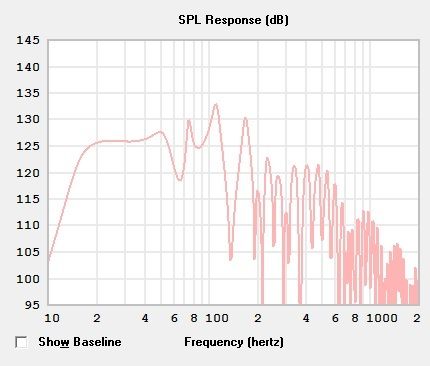
The reason you don't see them very often commercially is because they have to be very big ( long ) to work in the deep bass. PMC fold theirs and B&W coiled theirs in the Nautilus but it would be easy to build one into an AV wall.
If you want the best, and it looks like you're serious about getting it right, its they way to go.
You know the driver used for this sim, 12" Peerless XXLS 830845, which is the one BK use, there are 2 in parallel. Input at the terminals is only 20V / 100watts. The voice coils are hardly warmed up, excursion is in the linear region and half way to mechanical x-max.
 The harmonics are messy higher up because its a tapped horn but this design is optimised to be linear below 35Hz and everything above that is chopped by DSP. I have the amp and drivers ready at home; cabinets are coming along.........
The harmonics are messy higher up because its a tapped horn but this design is optimised to be linear below 35Hz and everything above that is chopped by DSP. I have the amp and drivers ready at home; cabinets are coming along......... 
Edited by Crackie on Thursday 23 April 06:30
OldSkoolRS said:
Funny that I was looking at Peerless drivers last night on Partsexpress website.
Perhaps the Monolith put me off ported due to blowing the driver twice, but I feel happier with sealed as I've not been able to kill my current ones.
The Peerless driver used in the Monolith would be happier in a sealed box or an enormous 200+ liter reflex box; asking it to play loud and deep in a relatively small reflex box could easily exceed x-max and damage the driver unless a very steep high pass filter is used. Perhaps the Monolith put me off ported due to blowing the driver twice, but I feel happier with sealed as I've not been able to kill my current ones.

I bought some of the drivers from BK and went down the 200+ liter reflex route.
Edited by Crackie on Tuesday 21st April 14:06
OldSkoolRS said:
If I had space for 2 x 200 litre boxes then it would be worth following up on looking at your response for such a low input signal. By comparison I have to put 1500 watts (RMS) into each of my subs to hit 110dB (at the MLP) as they are in fairly small boxes and sealed, so ported (and a large box) is much more efficient. I'd love an infinite baffle sub, but that isn't' possible.
I've been thinking that maybe I should just buy another pair of Fi Q15s, another iNuke6000DSP and then get four new boxes built. Same 60 litres volume, but as shallow as is possible to fit the speaker depth in. Put them in the 4 corners of the room, hidden 'inside' the front and rear false walls. Setting up 4 identical subs would be easier with only the delays to tweak (then the '88 would eq them as 'one').
It's all just at the ideas stage at the moment though. I like the results I get now, but no harm in trying to further improve things (I'm sure the '88 will help in this regard), but I also have an aversion to AV gear being visible, so I'm making things hard for myself by trying to hide all those subwoofer drivers, plus the 9/11 speakers once I go the full Atmos/DTS:X. I think I'm going to need a lot of AT fabric...
Just to clarify, the very efficient simulation above isn't ported it is a tapped horn; it also uses 2 drivers in parallel. The sim was made using Hornresponse software and is what I'm working on at the moment.I've been thinking that maybe I should just buy another pair of Fi Q15s, another iNuke6000DSP and then get four new boxes built. Same 60 litres volume, but as shallow as is possible to fit the speaker depth in. Put them in the 4 corners of the room, hidden 'inside' the front and rear false walls. Setting up 4 identical subs would be easier with only the delays to tweak (then the '88 would eq them as 'one').
It's all just at the ideas stage at the moment though. I like the results I get now, but no harm in trying to further improve things (I'm sure the '88 will help in this regard), but I also have an aversion to AV gear being visible, so I'm making things hard for myself by trying to hide all those subwoofer drivers, plus the 9/11 speakers once I go the full Atmos/DTS:X. I think I'm going to need a lot of AT fabric...
The 240L reflex loaded version only uses a single Peerless 830845 and is much less sensitive. Both subs will only be used below 30Hz; four, quarter wave loaded, Celestion Kevlar 12" drivers take care of 30Hz to 80Hz.
Here's the 240L ported simulation
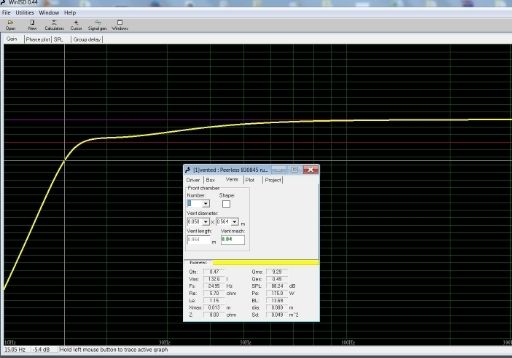
Here are individual nearfield measurements of the port and the driver.
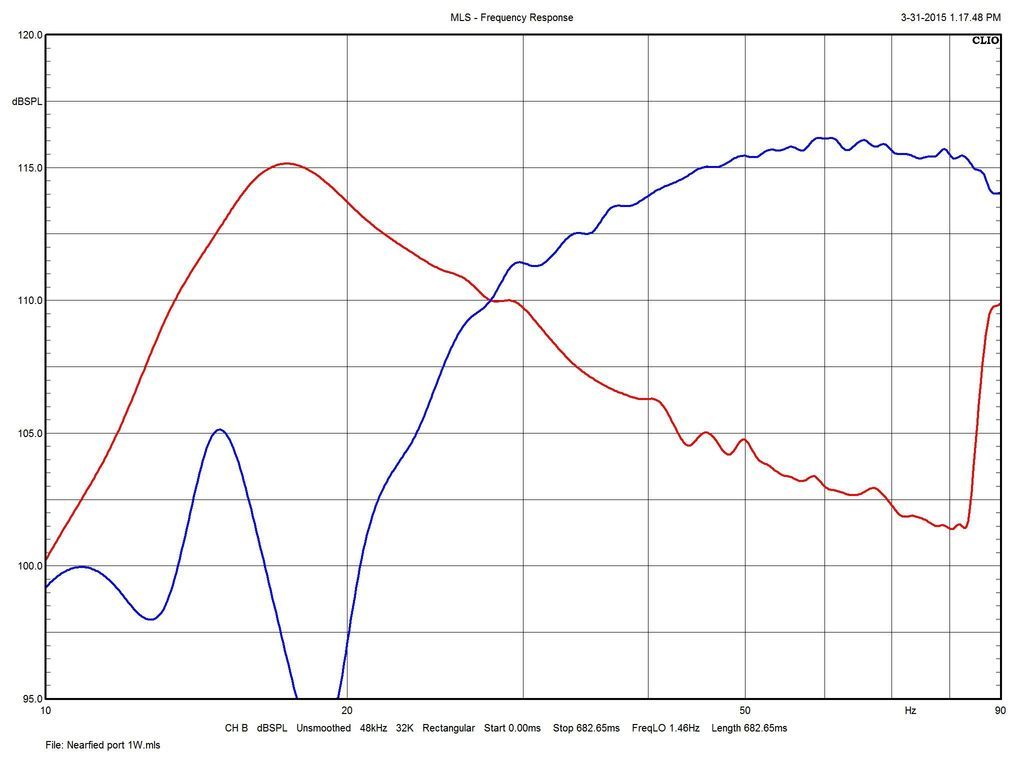
Unsmoothed Farfield in-room response with wide measurement window. The room modes make it look lumpy but the impedance measurement shows the 17.5Hz tuning and 'room averaged' measurements are extremely close to the simulation.
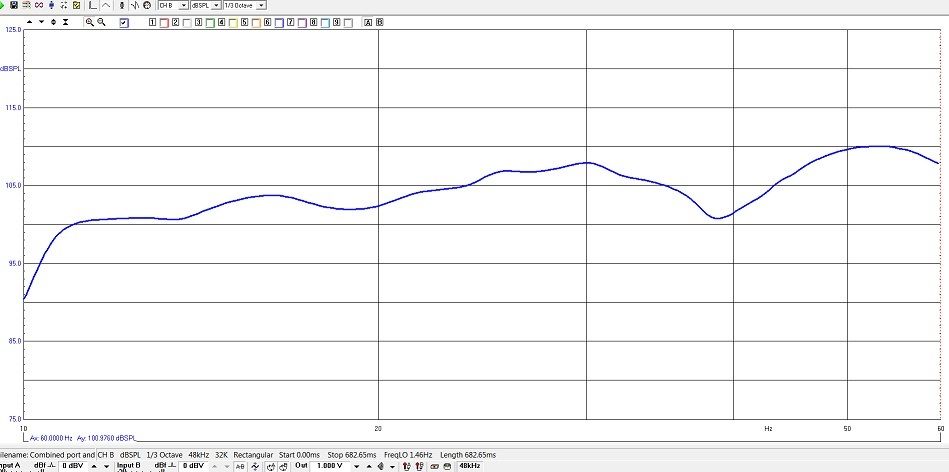
Finished speaker.
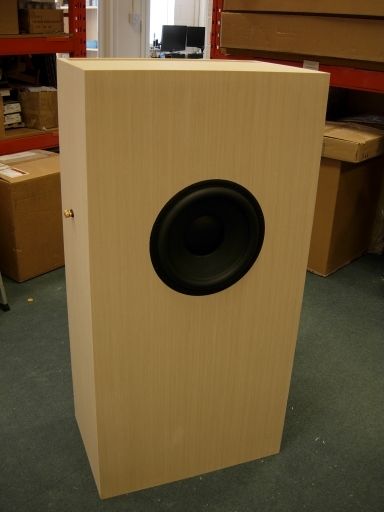
Edited by Crackie on Friday 1st May 16:26
David A said:
Not much to add other than I have one of these fairly rare hobbies SVS PB12 ultra/2
http://www.hometheatersound.com/equipment/svs_pb12...
With these dimensions it's a wee bit excessive
Dimensions: 26"H x 19"W x 29"D
Weight: 190 pounds
Must get a much much bigger house.
http://www.hometheatersound.com/equipment/svs_pb12...
With these dimensions it's a wee bit excessive
Dimensions: 26"H x 19"W x 29"D
Weight: 190 pounds
Must get a much much bigger house.
David, that big SVS has impressive performance; I did consider their big 13-Ultra cylinder a while ago but carried away with building my own in the end.
The ported sub above is a wee bit excessive too
Dimensions: 48"H x 24"W x 16"D
Weight: 102 Kg / 224 pounds on scales at work.
Bigger house already sorted.
 current one went on the market yesterday.
current one went on the market yesterday. telecat said:
The zero compromise 'architectural' types tend to frequent this forum. http://www.goodsoundclub.com/Forums/ShowPost.aspx?...Edited by Crackie on Friday 24th April 10:20
JustinP1 said:
When I record classical music it will have zero in that range, because I roll it off.
A number of reasons:
1) Most mics don't pick up in that range.
2) Most mic pre-amps actually will roll off that range anyway. Good mic pre-amps like Focusrite etc have the additional option of setting a high pass filter. The thinking is that this increases the fidelity of the captured audio without the worthless very low bass.
3) There is very little energy at those wavelengths because of the above, and
4) The realities of recording an orchestra on location or a studio is that a good proportion of the energy at those wavelengths will be stuff you want to exclude - rumblings from floors, traffic, extraneous sounds etc.
5) On top of all the above, when it comes to mastering, those frequencies are again rolled off. Two reasons, firstly to stop 'mega bass' type hifi stuff from just amplifying it and distorting it, and secondly once it goes to radio and they compress it for broadcast, your song would sound quieter in relation to the rest as the compressor would be affected by the low bass even though its inaudible.
On the last point, I remember a lecture from someone - I think it might have been Pete Waterman back in the day - saying that they would roll off everything low down, and even the bass would be more mid-range sounding so that their song would be less limited, and sound louder on the radio.
Have a listen to SAW stuff from the 80's and it's pretty noticeable!
So, in short, I wouldn't bother.
Hi Justin, thanks for the comprehensive reply; I appreciate your knowledge and experience in the recording field but your comments focus on microphone recording of real instruments and voices; the low frequency content of electronically generated music often very different. I started the subwoofer project(s) to be able to cover full range electronic music.A number of reasons:
1) Most mics don't pick up in that range.
2) Most mic pre-amps actually will roll off that range anyway. Good mic pre-amps like Focusrite etc have the additional option of setting a high pass filter. The thinking is that this increases the fidelity of the captured audio without the worthless very low bass.
3) There is very little energy at those wavelengths because of the above, and
4) The realities of recording an orchestra on location or a studio is that a good proportion of the energy at those wavelengths will be stuff you want to exclude - rumblings from floors, traffic, extraneous sounds etc.
5) On top of all the above, when it comes to mastering, those frequencies are again rolled off. Two reasons, firstly to stop 'mega bass' type hifi stuff from just amplifying it and distorting it, and secondly once it goes to radio and they compress it for broadcast, your song would sound quieter in relation to the rest as the compressor would be affected by the low bass even though its inaudible.
On the last point, I remember a lecture from someone - I think it might have been Pete Waterman back in the day - saying that they would roll off everything low down, and even the bass would be more mid-range sounding so that their song would be less limited, and sound louder on the radio.
Have a listen to SAW stuff from the 80's and it's pretty noticeable!
So, in short, I wouldn't bother.

Regarding whether to bother or not; I've already made the ported sub above. I'm fortunate to have access to a CNC at work so making a big sub, which can reproduce 15Hz cleanly and at good level, hasn't cost me too much. There's another sub design in the pipeline ( cab designed but not started yet ) and I wanted to hear people's thoughts/experiences about infrasound before starting to make it. Mrs Crackie isn't too impressed with the idea of another big enclosure in the house.........not when I explained it was 2.75m tall and 1000 liters.
Edited by Crackie on Sunday 26th April 08:56
JustinP1 said:
To do it properly, IMHO you'd need a sub for say 30Hz to 80Hz or whatever top end meets your speakers, and a specific sub for lower than 30Hz.
I have exactly that in mind........the main speakers in my current setup use four Celestion 12" paper/Kevlar woofers in 2.4m long quarter wave enclosures which cover 25Hz to 85Hz. The 240L Peerless reflex sub shown earlier in the thread, and the pictures below, is to cover below that; a digital active crossover sorts bandwidth, phase integration and delays etc. Regarding the B&W cinema system performing better than the IMAX setup. B&W's 800 series are very good; arguably the bigger PMCs, ATCs, Wilson Audios, Krells, Martens, Gryphons, Nolas, Magicos, Velodyne's etc etc are similarly well engineered and also capable of reference quality bass.
I'm delighted with how well build quality, if not my first attempts at veneering
 has turned out. In addition to the interlocking bracing, a lot of work went into the inspecting the impedance trace when fitting the constrained layer mass damping plates and standing wave damping used. Port area is very high at 282 square cm; internal and external openings are chamfered to keep turbulence to a minimum. The impedance measurement and the high power sinewave tests are very clean as a result.
has turned out. In addition to the interlocking bracing, a lot of work went into the inspecting the impedance trace when fitting the constrained layer mass damping plates and standing wave damping used. Port area is very high at 282 square cm; internal and external openings are chamfered to keep turbulence to a minimum. The impedance measurement and the high power sinewave tests are very clean as a result. 
Interlocking bracing

40Kg worth of constrained layer steel damping plates glued and screwed to the cabinet walls.
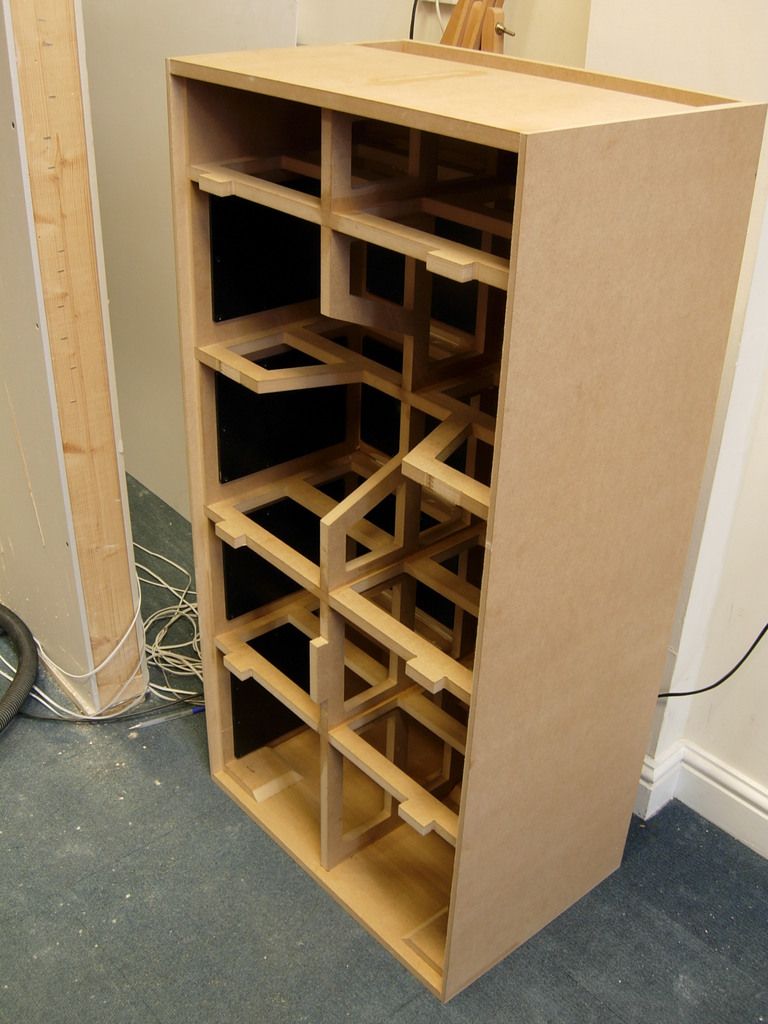
Standing wave damping is a combination of carpet underlay and denim batting.
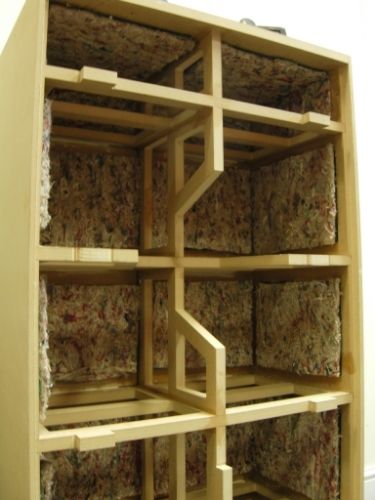
The benefit of going the extra mile with the bracing and damping is the extremely low total harmonic distortion (THD) result. The 122.5dB measurement in the graph below was taken at 12.5cm distance; this is equivalent to 105dB at 1m.
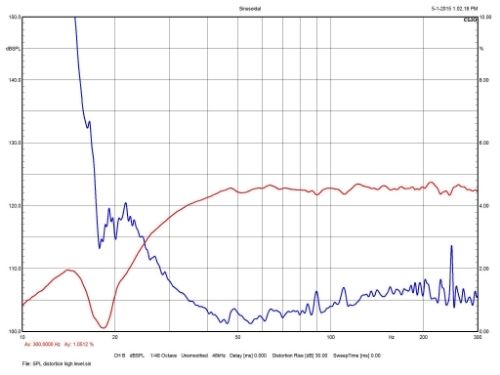
Edited by Crackie on Saturday 2nd May 23:40
Here's a link, http://www.eminence.com/pdf/LAB_12_cab.pdf.
Eminence themselves stress you need to take care with filtering.
You might be interested in the IB HT ( infinite baffle home theater series ) from Acoustic Elegance; developed specifically for home theater applications like yours. Sensible money too but you'll need to import them.
http://aespeakers.com/aes_store/catalog/product_in...
http://ibsubwoofer.blogspot.co.uk/2007/11/new-ae-i...
Eminence themselves stress you need to take care with filtering.
You might be interested in the IB HT ( infinite baffle home theater series ) from Acoustic Elegance; developed specifically for home theater applications like yours. Sensible money too but you'll need to import them.
http://aespeakers.com/aes_store/catalog/product_in...
http://ibsubwoofer.blogspot.co.uk/2007/11/new-ae-i...
Edited by Crackie on Saturday 25th April 07:38
OldSkoolRS said:
I missed you post above with the cabinet. Looks a very sturdy build, what device(s) are you going to use to set up the two subwoofer systems? I have the DSP in my iNuke to sort individual delays/filters/pre eq, plus probably the DDRC88A to eq all the subs as one item.
There is a MiniDSP 10 channel digital active crossover / pre-amp at the heart of my system. I use 8 channels to drive the main four way active system and the unused pair of outputs will control and optimise the subs.
Measurements are done by Clio, ARTA and Holmimpulse software via a Tascam audio interface. The active crossover sorts out the pass bands for the various drivers, the time alignments, phase correction, parametric driver EQ. Once that's all sorted the signals are fed via the MiniDSPs volume control to various power amps.
OldSkoolRS said:
That's great information Crackie. I've heard of Holmimpulse before, though I'm only using an UMIK-1 myself which is a USB mic, so I'm not able to do time based loop measurements. I might have to look into another mic/soundcard solution myself when I get started on my sub upgrade.
ARTA http://www.artalabs.hr/ and Holmimpulse http:/ /www.holmacoustics.com/holmimpulse.php are both incredible pieces of freeware. Holm is arguably the best for time alignment but overall ARTA is as capable a development tool as top commercial systems like CLIO or MLSSA. Check out the registered users on ARTA's website. Hi-Fi Choice have been using it for a while too. The program provides impulse response measurement, for real-time spectrum analysis and for real-time frequency response measurements. The ARTA program is also a powerful analyzer of gated impulse response, smoothed frequency response (in 1/n-octave bands), step response, impulse response envelope (ETC curve), cumulative spectral decay curve, energy decay in reverberant environments, room acoustical parameters and speech intelligibility measures - STI and RASTI.
The package includes modules to allow impedance, TSP, Harmonic distortion measurements as well as the usual sine and FFT suite.
Edited by Crackie on Sunday 26th April 20:29
Hi OldSkoolRS, thanks for the update/report. Pleased to hear that DIRAC is working well for you  . Their combination of IIR and FIR filter algorithms seems to be the best around now. Rolls Royce, Bentley, Naim Audio, OPPO, Pioneer, Theta, Barco, Datasat, Emotiva, Kreisel are using DIRAC Live too.
. Their combination of IIR and FIR filter algorithms seems to be the best around now. Rolls Royce, Bentley, Naim Audio, OPPO, Pioneer, Theta, Barco, Datasat, Emotiva, Kreisel are using DIRAC Live too.
My main speakers and the subs in this thread were designed specifically for the lounge of the house I'm moving into into later this year. I've been planning to get a DDRC88D for a while and your positive feedback is good to know; have to wait until after the move now though.
 . Their combination of IIR and FIR filter algorithms seems to be the best around now. Rolls Royce, Bentley, Naim Audio, OPPO, Pioneer, Theta, Barco, Datasat, Emotiva, Kreisel are using DIRAC Live too.
. Their combination of IIR and FIR filter algorithms seems to be the best around now. Rolls Royce, Bentley, Naim Audio, OPPO, Pioneer, Theta, Barco, Datasat, Emotiva, Kreisel are using DIRAC Live too. My main speakers and the subs in this thread were designed specifically for the lounge of the house I'm moving into into later this year. I've been planning to get a DDRC88D for a while and your positive feedback is good to know; have to wait until after the move now though.
Edited by Crackie on Friday 22 May 06:29
OldSkoolRS said:
Best of luck with the move, be interested to hear how you get on with your speakers/sub if you try the '88 yourself.
Curious to find out what the '88 can do too..........I'm moving back to a house I've lived in previously; the lounge is very close to the ideal Fibonacci/golden ratio, built from stone and pretty big too ( 5000+ cubic feet ). Any system I've used in that room in the past has sounded incredible so it will be interesting to hear ( and measure ) if the DIRAC can improve on what is already a great room. Edited by Crackie on Thursday 21st May 20:35
sparkyhx said:
Anything digital has a lower end cut off, so its not even there to reproduce.
Source performance can be a factor but I don't agree with "Anything digital has a lower end cut off"; the lower limit for CD is generally held to be 2Hz. In practice, the lower end cut off frequency is determined by the source manufacturer's DAC and output stage filtering.Most CD players I've seen measure flat down to approx. 10Hz with progressive roll off down to approx. -3.0dB at 5Hz. There's usually steep filtering below that. There are exceptions; I have a pair of old 1990s Technics players and they're both flat down to 2Hz, if their specs are accurate.
Edited by Crackie on Friday 22 May 06:38
Gassing Station | Home Cinema & Hi-Fi | Top of Page | What's New | My Stuff




